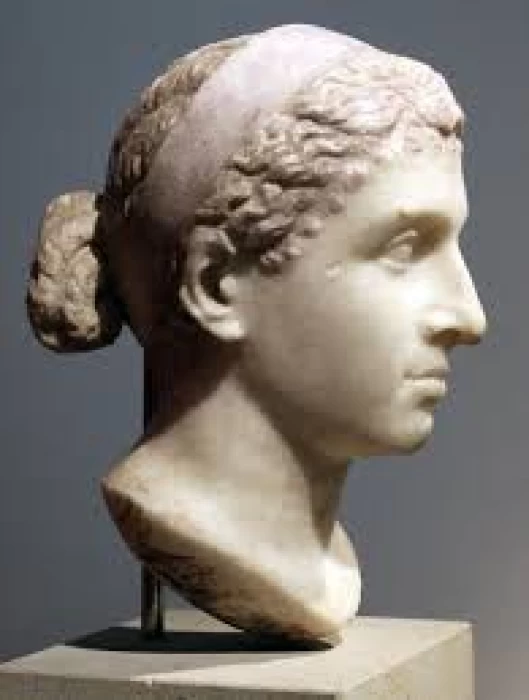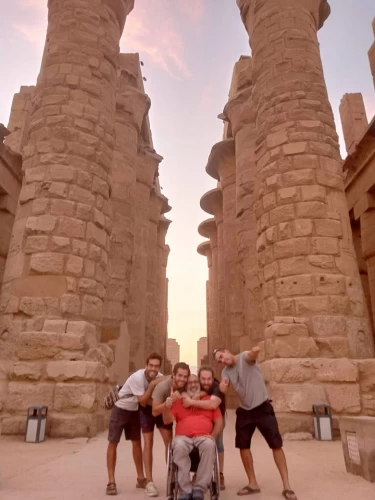
Cleopatra VII | Cleopatra Philopator | The Macedonian Dynasty in Egypt
Cleopatra VII | Cleopatra Philopator
Cleopatra, the daughter of Ptolemy XII Auletes, also known as Cleopatra Philopator, was the final acting ruler of Egypt’s extinguishing Ptolemaic dynasty. (69 BCE) was an heir to the Ptolemaic Macedonian-Greek dynasty, which traced its lineage back to Ptolemy I Soter, a general of Alexander the Great. She is renowned as one of the most beautiful women in history, a poet, writer, and others. She is also known for seducing two of Rome’s most famous people, Julius Caesar and Mark Antony, and thus making a political impact on Rome. Her interesting life and the time of her reign have fascinated historians, artists, and authors from ancient times to today, making her one of the most iconic figures of the ancient world.
Early Life and Rise to Power
Cleopatra was the daughter of Ptolemy XII Auletes of Egypt. Who her mother is remains unknown, including whether or not she was a member of the Ptolemaic dynasty. Cleopatra was a well-educated and fluent speaker of many languages including Greek, Egyptian, and the ones mentioned above as well. On the contrary, other queens were trying to adjust to the culture of the Greek and were ruling with the Egytian’s structure of their kingdoms.
In 51 BCE, Cleopatra was named,, together with her younger brother andhusband,d Ptolemy XIII, as co-ruler of Egypt, following the Ptolemaic practice of sibling marriage. But their relationship could not go without struggles, which ultimately resulted in a rebellion. In her pursuit of the throne, she came across Julius Caesar, who had just entered Egypt in 48 BCE during the pursuit of Pompey the Great. Cleopatra is famous for smuggling herself into Caesar’s presence rolled up on a carpet, an event that has reached mythical status by now.
Alliance with Julius Caesar
Cleopatra's collaboration with Julius Caesar was both personal and political. With assistance provided by Caesar, she was able to restore her throne and held the position of co-regent with her younger brother, Ptolemy XIV. A child, Ptolemy XV Caesar, with whom Cleopatra and Caesar were linked.
Relationship with Mark Antony
After the death of Julius Caesar in 44 BCE, Cleopatra came back to Egypt, and among the turmoil of the Roman Republic, she tried to entrench her authority. In 41 BCE, she got engaged with Mark Antony, one of Rome’s triumvirates, both romantically and politically. Their relationship was controversial and in the military perspective, it was a good strategy because it was intended to join the forces of Egypt and Rome against the mutual enemy.
It is known that Cleopatra and Antonius had three offspring: Alexander Helios, Cleopatra Selene II, and Ptolemy Philadelphus. They, in a lavish style, together stayed and became the object of the whole Roman propaganda. Augustus, a name he got later on, used the relationship to gain opposition for the Romans and pictured Cleopatra as an outsider woman who was insinuating values of Rome.
The Battle of Actium and Cleopatra’s Downfall
As a result of the union of Cleopatra and Antonius, it blue-penciled them. Forty-one BCE is the year when they united forces and at the same time marked their torment. The alliance of the two was dissolved in the end, and the battle of Actium decided the question in 31 BCE as their combined forces encountered Octavian’s navy.
Facing the situation of victory, Cleopatra and Antony both preferred to die by suicide. Antony fell on his sword, while Cleopatra was said to have allowed the asp, a poisonous snake, to bit her. Her end became the end of the Ptolemaic dynasty and Egypt was made a part of the empire of Rome.
Ceopatraus’s Legacy
The life and government of Cleopatra are the themes of many art-forms, pieces of literature, and numerous works of historical research. As a matter of fact, she is seen by the most as one smart and efficient ruler who was trying to save Egypt’s independence from the spread of Rome. The historians in Rome frequently pictured her as a woman who climbed the ladder by using various ways of flattery and as an executioner of people for her own gains, but, contemporary scholars have reviewed the story of her life, and have given her credit for her intelligence, political acumen, and cultural adaptability.
Cleopatra's Early Education and Cultural Strategy
Cleopatra was a ruler who was also a polyglot and a scholar. Her knowledge of these aspects put her on a different level from other members of her dynasty. She was the first Ptolemaic ruler to know and accept the Egyptian language and traditions, which had the effect of bringing her closer to the people. The inherent feature of this adaptability to the local culture of Egypt was the establishment of her position as a "pharaoh" in the eyes of the Egyptian people, bringing closer the Greek ruling elite and the native population.
Cleopatra, in addition to philosophy, mathematics, astronomy, and medicine, was proficient in these studies. Her education was key to her potential to build relationships with powerful allies and adversaries, such as Julius Caesar and Mark Antony. It was through it that she became a skillful political strategist who skillfully steered the often intertwined and complex streams of domestic and international politics.
Her Role as Pharaoh and Religious Significance
Pharaoh, the primary role of Cleopatra, was that of one who claimed divine status, holding a public relation with the goddess Isis. At the same time, she did the equating of herself with the goddess Isis, who was the very same goddess of the Egyptians. This matching result demonstrated not only her power but also that she was a religious community leader. Cleopatra’s being the "New Isis" was a tactful move to show that she was right and loyal about promoting peace and unity at an unstable time.
Cleopatra’s Political Savvy
Cleopatra's special gift was her ability to balance alliances and, at the same time, keep her independence within a world ordered by the Romans. She was not only the partner of Julius Caesar and Mark Antony, but their unions were very instrumental in the consolidation of her power and the protectiveness of the Egyptian sovereignty. Cleopatra was a visionary who viewed her aspirations in the long term. She aimed at establishing an empire that would link her Hellenistic-Egyptian legacy to Rome’s power and give her supremacy over them.
She capitalized on Egypt’s wealth and materials, particularly in its grain sector, to have a hold on her affairs with Rome. Since the resource was very important, she had the upper hand as Rome was heavily dependent on the import of Egyptian grain to feed its population.
Cleopatra and the Roman Perception of Women
Cleopatra was as intelligent and influential as she was at odds with the traditional patriarchal Roman views of women, the most acute when women gain power. The rulers of Rome were always against her, and their propaganda always represented her as a femme fatale whose only way to control men was by seducing them with her eyes and ignoring her skills as a politician. This image was based on the Roman culture, which at the time was highly patriarchal and had a rule-discrediting tendency.
In fact, Cleopatra was a knowledgeable diplomat who loved her country most of all and owed her role as monarch to this. Her being an autocrat who could manage to rule and impact a male-dominated world was and still is evidence of the strength and toughness that she had and kept.
Legacy in Art, Literature, and Modern Culture
Cleopatra’s story has inspired a wealth of artistic and literary works, from Plutarch’s historical accounts to Shakespeare’s play Antony and Cleopatra. In modern times, her life has been the subject of numerous films, novels, and scholarly studies, each offering a unique interpretation of her character.
Key themes in Cleopatra’s legacy include:
The Dichotomy of Power and Femininity: Cleopatra embodied both, challenging stereotypes about women in leadership.
Cultural Fusion: Her reign highlighted the blending of Egyptian and Hellenistic traditions, showcasing the complexities of identity in a multicultural empire.
End of an Era: Cleopatra’s death symbolized the end of Egypt as a sovereign power and its integration into the Roman Empire, marking a significant historical turning point.
Fascination with Cleopatra’s Death
The circumstances of Cleopatra’s death remain one of the most debated aspects of her life. While the popular account suggests she allowed herself to be bitten by an asp, some historians propose alternative theories, including the possibility of poisoning. Her choice to die on her terms rather than face humiliation in Rome reflects her determination to control her legacy, even in the face of defeat.
The last queen of the Ptolemaic dynasty, Cleopatra's name means "glory of her father," and her passing brought an end to Egypt's Hellenistic era. Reliable depictions of her face have rarely survived to this day, despite the fact that she is one of the most remembered figures from ancient Egypt.
Cleopatra VII is probably among the most famous characters of ancient Egypt and of all history, she was the last pharaoh of the Ptolemaic era, which began with Ptolemy I, to reign over the Kingdom of Egypt and also the last of the whole Hellenistic period, which began with Alexander the Great and whose end corresponds precisely with his death.
Cleopatra, the daughter of Ptolemy XII Auletes, also known as Cleopatra Philopator, was the final acting ruler of Egypt’s extinguishing Ptolemaic dynasty. (69 BCE) was an heir to the Ptolemaic Macedonian-Greek dynasty, which traced its lineage back to Ptolemy I Soter, a general of Alexander the Great. She is renowned as one of the most beautiful women in history, a poet, writer, and others. She is also known for seducing two of Rome’s most famous people, Julius Caesar and Mark Antony, and thus making a political impact on Rome. Her interesting life and the time of her reign have fascinated historians, artists, and authors from ancient times to today, making her one of the most iconic figures of the ancient world.
Cleopatra was the daughter of Ptolemy XII Auletes of Egypt. Who her mother is remains unknown, including whether or not she was a member of the Ptolemaic dynasty. Cleopatra was a well-educated and fluent speaker of many languages including Greek, Egyptian, and the ones mentioned above as well. On the contrary, other queens were trying to adjust to the culture of the Greek and were ruling with the Egytian’s structure of their kingdoms.
In 51 BCE, Cleopatra was named,, together with her younger brother andhusband,d Ptolemy XIII, as co-ruler of Egypt, following the Ptolemaic practice of sibling marriage. But their relationship could not go without struggles, which ultimately resulted in a rebellion. In her pursuit of the throne, she came across Julius Caesar, who had just entered Egypt in 48 BCE during the pursuit of Pompey the Great. Cleopatra is famous for smuggling herself into Caesar’s presence rolled up on a carpet, an event that has reached mythical status by now.
Cleopatra's collaboration with Julius Caesar was both personal and political. With assistance provided by Caesar, she was able to restore her throne and held the position of co-regent with her younger brother, Ptolemy XIV. A child, Ptolemy XV Caesar, with whom Cleopatra and Caesar were linked.
After the death of Julius Caesar in 44 BCE, Cleopatra came back to Egypt, and among the turmoil of the Roman Republic, she tried to entrench her authority. In 41 BCE, she got engaged with Mark Antony, one of Rome’s triumvirates, both romantically and politically. Their relationship was controversial and in the military perspective, it was a good strategy because it was intended to join the forces of Egypt and Rome against the mutual enemy.


















